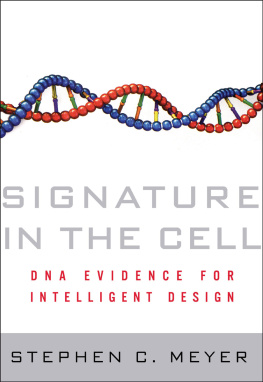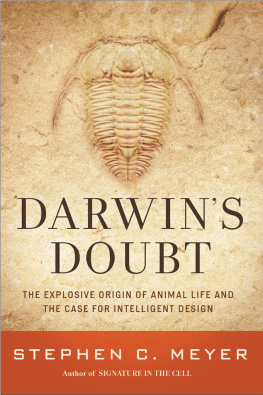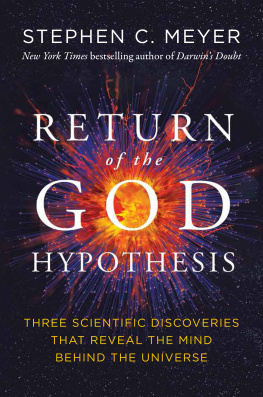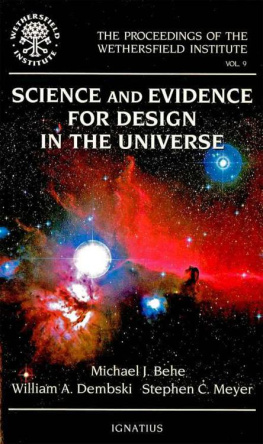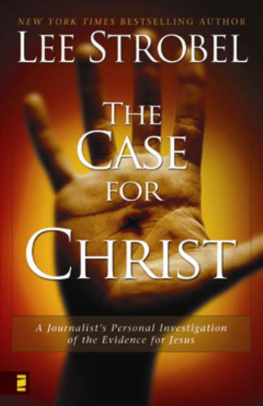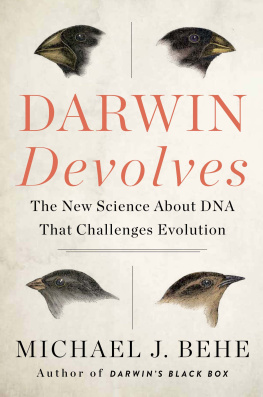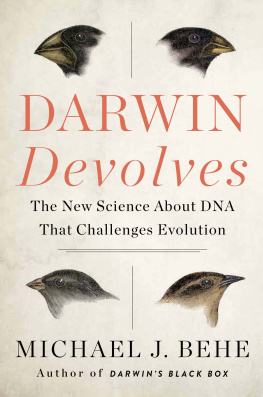Stephen C. Meyer
Contents
DNA, Darwin, and the Appearance of Design
The Evolution of a Mystery and Why It Matters
The Double Helix
Signature in the Cell
The Molecular Labyrinth
The Origin of Science and the Possibility of Design
Of Clues to Causes
Chance Elimination and Pattern Recognition
Ends and Odds
Beyond the Reach of Chance
Self-Organization and Biochemical Predestination
Thinking Outside the Bonds
Chance and Necessity, or the Cat in the Hat Comes Back
The RNA World
The Best Explanation
Another Road to Rome
But Does It Explain?
But Is It Science?
Sauce for the Goose
Why It Matters
A Living Science
Some Predictions of Intelligent Design
Multiverse Cosmology and the Origin of Life
Dad, thats you! my fourteen-year-old son exclaimed as he looked at the newspaper while we stood waiting to check out at the tiny general store. His shock at seeing my face in the front section of the Seattle Post-Intelligencer, when he just went to look for baseball scores, was no doubt compounded by his awareness of our location.1 The general store on Shaw Island, one of the most remote in the San Juan chain north of Puget Sound, was the only commercial establishment on the island. This irony was not lost on my wife, whose raised eyebrow said it all. I thought we were coming here to get away from all of this. We were. But then how was I to know that the local Seattle paper would rerun the previous days front-page story from the New York Times about the program of scientists I directed and the controversy surrounding our work?2
The controversy about the origin of life and whether it arose from an undirected material process or from some kind of designing intelligence is not new. It goes back in Western civilization at least as far as the ancient Greeks, who produced philosophers representing both schools of thought. But the controversy over the contemporary theory of intelligent design (ID) and its implied challenge to orthodox evolutionary theory became big news beginning in 2004 and 2005. And, for better or worse, I found myself right in the middle of it.
Three events sparked intense media interest in the subject. First, in August 2004, a technical journal housed at the Smithsonian Institution in Washington, D.C., called the Proceedings of the Biological Society of Washington published the first peer-reviewed article explicitly advancing the theory of intelligent design in a mainstream scientific periodical. After the publication of the article, the Smithsonians Museum of Natural History erupted in internal controversy, as scientists angry with the editoran evolutionary biologist with two earned Ph.D.squestioned his editorial judgment and demanded his censure. Soon the controversy spilled over into the scientific press as news stories about the article and editors decision appeared in Science, Nature, The Scientist, and the Chronicle of Higher Education. 3
The media exposure fueled further embarrassment at the Smithsonian, resulting in a second wave of recriminations. The editor, Richard Sternberg, lost his office and his access to scientific samples and was later transferred to a hostile supervisor. After Sternbergs case was investigated by the U.S. Office of Special Counsel, a government watchdog organization, and by the U.S. House Committee on Government Reform, a congressional committee, other questionable actions came to light.4 Both investigations found that senior administrators at the museum had interrogated Sternbergs colleagues about Sternbergs religious and political beliefs and fomented a misinformation campaign designed to damage his scientific reputation and encourage his resignation.5 Sternberg did not resign his research appointment, but he was eventually demoted.
As word of his mistreatment spread, the popular press began to run stories about his case. Ordinarily, my reaction to such reports might have been to shake my head in dismay and move on to the next story in the news cycle. But in this case, I couldnt. As it happened, I was the author of the offending article. And some of the reporters interested in Sternbergs mistreatment were coming to me with questions. They wanted to know more about the theory of intelligent design and why it had provoked such alarm among establishment scientists.
Then in December 2004, two other events generated worldwide interest in the theory of intelligent design. First, a renowned British philosopher, Antony Flew, announced that he had repudiated a lifelong commitment to atheism, citing, among other factors, evidence of intelligent design in the DNA molecule.6 Flew noted in his announcement that his views about the origin of life bore a striking resemblance to those of American design theorists. Again, intelligent design was in the news. But what was it? This time I found myself on the BBC debating a prominent evolutionary biologist about the theory.
Later in the month, the American Civil Liberties Union (ACLU) announced a suit against a school board in the western Pennsylvania town of Dover. The school board had just announced its intention to let high school students learn about the theory of intelligent design. To do this, it proposed to inform students about the existence of a book in the school libraryone that made the case for intelligent design in opposition to the standard evolutionary theories presented in the existing biology textbooks. When the ACLU announced its own intentions to sue, the national media descended upon the town en masse.
The press corps covering the story no doubt already knew about the 1925 Scopes monkey trial from the fictionalized Spencer Tracy movie Inherit the Wind, if from no other source. In Dover they sensed they had the makings of a sequel. During 2005, all the major American network and cable news programs ran segments about the theory of intelligent design, the Dover controversy, or both. Stories not only appeared in major U.S. newspapers, but in papers around the world, from the Times of London, Sekai Nippo (Tokyo), the Times of India, and Der Spiegel to the Jerusalem Post .
Then in August 2005, just as an end to the media buzz seemed near, a number of political and religious leadersincluding figures as diverse as the Dalai Lama, President George W. Bush, and the popemade public statements supportive of either intelligent design or allowing students to learn about the controversy surrounding it. When Time magazine followed suit with a cover story about the controversy, our phones started ringing all over again.
As summer was drawing to an end, my wife and I decided it was time for our family to get away after friends offered us the use of their island cabin. But in the two-week period corresponding to our vacation, the New York Times ran its two front-page stories about our program at the Discovery Institute, the Washington Post broke a story about the latest developments in the Sternberg case, and the New York Times editorial page offered criticism of Sternberg in its main staff-written editorial.7 After Sternberg decided to appear on The OReilly Factor to tell his side of the story, we knew it was time to head back to Seattle.8
My temporary notoriety provided something my colleagues and I sorely neededa platform for correcting much of the misinformation circulating about the theory of intelligent design. Many news articles and reports confused intelligent design with biblical creationism and its literal reading of the book of Genesis. Other articles echoed the talking points of our critics and portrayed our work as either giving up on science or a sneaky attempt to circumvent the legal prohibitions against teaching creationism in the public schools that the Supreme Court had enacted in 1987.

